Structural Performance of Fiber-Reinforced Cementitious Composite Members Reinforced with Fiber-Reinforced Polymer Bars: A Systematic Review
Abstract
1. Introduction
2. Research Methodology
2.1. Searching Staratagy
2.2. Search Result
3. Bond Behavior and Bond Strength
3.1. Influence of Bar Diameter, Modulus of Elasticity, and Surface of the Bar
3.2. Influence of Embedded Length
3.3. Influence of FRCC or ECC Characteristics
4. Flexural Behavior
5. Ductility Evaluation
6. Shear and Torsional Performance
7. Durability Performance
8. Conclusions
- The bond behavior between FRP bars and FRCC is complex and influenced by factors such as bar diameter, surface treatment, and the characteristics of the FRCC matrix.The bond strength decreases when the bar diameter and embedded length increase. It improves as both the amount of fiber and the size of the cross-section of FRCC increases. Further research is needed to develop reliable models for predicting bond strength and performance, as existing studies show variability in results based on different experimental setups and material properties.
- FRCC members reinforced with FRP bars exhibit superior load-carrying capacities and ductility compared to conventional RC, highlighting their potential for improved structural performance. Type of FRP, reinforcement ratio, and environmental conditions are some of the factors that highly affect the flexural and ductility performance of these members.
- The shear capacity of FRCC members reinforced with FRP bars increases with low longitudinal reinforcement ratio, higher shear reinforcement ratio, or low shear span ratio.
- It was found that the torsional resistance of FRCC members reinforced with FRP bars is more dependent on the height/width ratio than the reinforcement ratio.
9. Recommendations for Future Studies
- Lack of comprehensive experimental studies that cover a wide range of FRCC and FRP combinations has led to insufficient data on their performance under various loading conditions, such as dynamic, cyclic, or impact loads.
- There are inconsistencies in findings across different studies, which could arise from variations in testing methods, material properties, and environmental conditions. This validity makes it challenging to draw a definitive conclusion.
- There are fewer studies on bond behavior under different loading scenarios and environmental conditions. More research is needed to develop reliable predictive models.
- More research on the environmental impact of producing and using FRCC and FRP materials, including life cycle assessment, is needed.
- There are insufficient design guidelines or standards specifically made for the use of FRCC and FRP in structural applications, which could limit their adoption in engineering practice.
Author Contributions
Funding
Conflicts of Interest
Abbreviations
| FRCC | Fiber-reinforced cementitious composite |
| FRP | Fiber-reinforced polymer |
| FRC | Fiber-reinforced concrete |
| ECC | Engineered cementitious composite |
| GFRP | Glass fiber-reinforced polymer |
| CFRP | Carbon fiber-reinforced polymer |
| AFRP | Aramid fiber-reinforced polymer |
| BFRP | Basalt fiber-reinforced polymer |
| SF | Steel fiber |
| PE | Polyethylene |
| PVA | Polyvinyl alcohol |
| PP | Polypropylene |
| SHCC | Strain hardening cementitious composite |
| DFRCC | Ductile fiber-reinforced cementitious composite |
| SF | Silica fume |
| FA | Fly ash |
| GBFS | Ground granulated blast furnace |
| HM | High modulus of elasticity |
| LM | Low/standard modulus of elasticity |
| SC-GFRP | Sand-coated GFRP |
| HW-GFRP | Helically wrapped GFRP |
| SS-ECC | Sea-water sea-sand ECC |
| FR-ECC | Fresh water ECC |
| UHP-ECC | Ultra-high performance ECC |
| SEM | Scanning electron microscope |
| CT | X-ray computed tomography |
References
- Soric, Z.; Kisicek, T.; Galic, J. Deflections of Concrete Beams Reinforced with FRP bars. Mater. Struct. 2010, 43, 73–90. [Google Scholar] [CrossRef]
- Nanni, A.; De Luca, A.; Jawaheri, Z.H. Reinforced Concrete with FRP Bars, 1st ed.; CRC Press: New York, NY, USA, 2014. [Google Scholar] [CrossRef]
- ACI 440.1R-16; Guide for the Design and Construction of Structural Concrete Reinforced with FRP Bars. American Concrete Institute: Farmington Hills, MI, USA, 2016.
- Said, H. Deflection Prediction for FRP-Strengthened Concrete Beams. J. Compos. Constr. 2010, 14, 244–248. [Google Scholar] [CrossRef]
- Ge, W.J.; Ashour, A.; Ji, X.; Cai, C.; Cao, D.F. Flexural Behavior of ECC-Concrete Composite Beams Reinforced with Steel Bars. Constr. Build. Mater. 2018, 159, 175–188. [Google Scholar] [CrossRef]
- Labib, W. Fibre Reinforced Cement Composites. In Cement-Based Materials; Saleh, H.E.-D.M., Rahman, R.O.A., Eds.; InTech: London, UK, 2018. [Google Scholar] [CrossRef]
- Kim, D.; Naaman, A.; El-Tawil, S. Comparative Flexural Behavior of Four Fiber Reinforced Cementitious Composites. Cem. Concr. Compos. 2008, 30, 917–928. [Google Scholar] [CrossRef]
- Lin, C.; Kayali, O.; Morozov, E.; Sharp, D. Influence of Fibre Type on Flexural Behaviour of Self-Compacting Fibre Reinforced Cementitious Composites. Cem. Concr. Compos. 2014, 51, 27–37. [Google Scholar] [CrossRef]
- Bentur, A.; Mindess, S. Fibre Reinforced Cementitious Composites, 2nd ed.; Taylor & Francis: London, UK, 2007. [Google Scholar]
- Tahmouresi, B.; Nemati, P.; Asadi, M.; Saradar, A.; Mohtasham, M. Mechanical Strength and Microstructure of Engineered Cementitious Composites: A New Configuration for Direct Tensile Strength, Experimental and Numerical Analysis. Constr. Build. Mater. 2021, 269, 121–136. [Google Scholar] [CrossRef]
- Zhu, Y.; Zhang, Z.; Yang, Y.; Yao, Y. Measurement and Correlation of Ductility and Compressive Strength for Engineered Cementitious Composites (ECC) Produced by Binary and Ternary Systems of Binder Materials: Fly Ash, Slag, Silica Fume, and Cement. Constr. Build. Mater. 2014, 68, 192–198. [Google Scholar] [CrossRef]
- Shuxin, W.; Victor, C.L. Engineered Cementitious Composites with High-Volume Fly Ash. Mater. J. 2007, 104, 233–241. [Google Scholar] [CrossRef]
- Lim, I.; Chern, J.C.; Liu, T.; Chan, Y.W. Effect of Ground Granulated Blast Furnace Slag on Mechanical Behavior of PVA-ECC. J. Mar. Sci. Technol. 2012, 20, 11. [Google Scholar] [CrossRef]
- Wu, Z.; Yin, J. Fracturing Behaviors of FRP-Strengthened Concrete Structures. Eng. Fract. Mech. 2003, 70, 1339–1355. [Google Scholar] [CrossRef]
- Ge, W.; Ashour, A.F.; Cao, D.; Lu, W.; Gao, P.; Yu, J. Experimental Study on Flexural Behavior of ECC-Concrete Composite Beams Reinforced with FRP Bars. Compos. Struct. 2019, 208, 454–465. [Google Scholar] [CrossRef]
- Carrera, A.; Ochoa, W.; Larrinaga, F.; Lasa, G. How to conduct a systematic literature review: A quick guide for computer science research. MethodsX 2022, 9, 101895. [Google Scholar] [CrossRef]
- Available online: https://osf.io/gkt5f (accessed on 4 July 2025).
- Falagas, M.; Pitsouni, E.; Malietzis, G.; Pappas, G. Comparison of PubMed, Scopus, Web of Science, and Google Scholar: Strengths and Weaknesses. FASEB J. 2008, 22, 338–342. [Google Scholar] [CrossRef] [PubMed]
- Available online: https://www.webofscience.com/wos/woscc/summary/b14ae2ac-ec76-4797-b0a0-ff400c383dc0-015cbcbed7/relevance/1 (accessed on 3 April 2025).
- Zhao, D.; Zhou, Y.; Xing, F.; Sui, L.; Ye, Z.; Fu, H. Bond Behavior and Failure Mechanism of Fiber Reinforced Polymer Bar–Engineered Cementitious Composite Interface. Eng. Struct. 2021, 243, 112520. [Google Scholar] [CrossRef]
- Li, Q.; Fu, M.; Xie, B. Analyzing the Bond Behavior of Fiber-Reinforced Polymer (FRP) Bars Embedded in Engineered Cementitious Composites (ECCs) with the Nonlocal Continuum Rod Model. Math. Probl. Eng. 2020, 2020, 1710364. [Google Scholar] [CrossRef]
- Takasago, S.; Kanakubo, T.; Kobayashi, H.; Sasaki, H. Bond and Cracking Characteristics of PVA-Fiber-Reinforced Cementitious Composite Reinforced with Braided AFRP Bars. Fibers 2023, 11, 107. [Google Scholar] [CrossRef]
- Hossain, K. Bond Strength of GFRP Bars Embedded in Engineered Cementitious Composite using RILEM Beam Testing. Int. J. Concr. Struct. Mater. 2018, 12, 6. [Google Scholar] [CrossRef]
- Cao, J.; Wu, F.; Zhao, B.; Lei, H.; Li, Z.; Chen, A. Experimental and Analytical Investigations for the Bond Slip and Anchorage Design Between BFRP Bar and Engineered Cementitious Composites. Structures 2024, 68, 107075. [Google Scholar] [CrossRef]
- Wang, H.; Sun, X.; Peng, G.; Luo, Y.; Ying, Q. Experimental Study on Bond Behaviour between BFRP Bar and Engineered Cementitious Composite. Constr. Build. Mater. 2015, 95, 448–456. [Google Scholar] [CrossRef]
- Wang, H.; Wu, L.; Xu, X.; Lin, Z. Experimental Study on Bond Durability of GFRP Bar/Engineered Cementitious Composite Exposed to Freeze-Thaw Environments. J. Build. Eng. 2024, 84, 108592. [Google Scholar] [CrossRef]
- Wei, J.; Ke, L.; Wang, P.; Li, W.; Leung, C. Microstructure, Mechanical Properties and Interaction Mechanism of Seawater Sea-Sand Engineered Cementitious Composite (SS-ECC) with Glass Fiber Reinforced Polymer (GFRP) bar. Compos. Struct. 2024, 343, 118302. [Google Scholar] [CrossRef]
- Kim, B.; Lee, J.Y. Polyvinyl Alcohol Engineered Cementitious Composite (PVA-ECC) for the Interfacial Bond Behaviour of Glass Fibre Reinforced Polymer Bars (GFRP). Polym. Polym. Compos. 2012, 20, 545–558. [Google Scholar] [CrossRef]
- Wu, L.; Wang, H.; Xu, X.; Lin, Z. Investigation on Bond Durability of GFRP bar/Engineered Cementitious Composite Under Alkaline-Saline Environments. J. Build. Eng. 2023, 77, 107343. [Google Scholar] [CrossRef]
- Godat, A.; Aldaweela, S.; Aljaberi, H.; Al Tamimi, N.; Alghafri, E. Bond Strength of FRP Bars in Recycled Aggregate Concrete. Constr. Build. Mater. 2021, 267, 120919. [Google Scholar] [CrossRef]
- CSA S806-12; Design and Construction of Building Components with Fiber-Reinforced Polymers. Canadian Standards Association: Toronto, ON, Canada, 2012.
- CSA S6-06; Canadian Highway Bridge Design Code (CHBDC). Canadian Standards Association: Toronto, ON, Canada, 2006.
- ACI 440.1R-15; ACI Committee 440. Guide for the Design and Construction of Structural Concrete Reinforced with FRP Bars. American Concrete Institute: Farmington Hills, MI, USA, 2015.
- Yuan, F.; Pan, J.; Leung, C. Flexural Behaviors of ECC and Concrete/ECC Composite Beams Reinforced with Basalt Fiber-Reinforced Polymer. J. Compos. Constr. 2013, 17, 591–602. [Google Scholar] [CrossRef]
- Cai, J.; Pan, J.; Zhou, X. Flexural Behavior of Basalt FRP Reinforced ECC and Concrete Beams. Constr. Build. Mater. 2017, 142, 423–430. [Google Scholar] [CrossRef]
- Fischer, G.; Victor, C.L. Deformation Behavior of Fiber-Reinforced Polymer Reinforced Engineered Cementitious Composite (ECC) Flexural Members under Reversed Cyclic Loading Conditions. Struct. J. 2003, 100, 25–35. [Google Scholar] [CrossRef]
- Zhou, J.; Xia, G.; Wang, P.; Zhao, J.; Xu, L.; Pan, J. Investigation of Flexural Cracks in Engineered Cementitious Composites Beams Reinforced with CFRP Bars. Constr. Build. Mater. 2024, 438, 136900. [Google Scholar] [CrossRef]
- Wang, Y.; Wang, G.; Guan, Z.; Ashour, A.; Ge, W.; Zhang, P. The Effect of Freeze–Thaw Cycles on Flexural Behaviour of FRP-reinforced ECC beams. Archiv. Civ. Mech. Eng. 2021, 21, 101. [Google Scholar] [CrossRef]
- Al Marahla, R.; Shehzad, M.; Garcia, E. Flexural and Deflection Behaviour of Synthetic Fibre Reinforced Concrete Beams Reinforced with Glass Fibre Reinforced Polymer Bars under Sustained Service Load. Structures 2023, 54, 946–955. [Google Scholar] [CrossRef]
- Attia, K.; Alnahhal, W.; Elrefai, A.; Rihan, Y. Flexural Behavior of Basalt Fiber-Reinforced Concrete Slab Strips Reinforced with BFRP and GFRP Bars. Compos. Struct. 2019, 211, 1–12. [Google Scholar] [CrossRef]
- Abushanab, A.; Alnahhal, W. Numerical Parametric Investigation on the Moment Redistribution of Basalt FRC Continuous Beams with Basalt FRP Bars. Compos. Struct. 2021, 277, 114618. [Google Scholar] [CrossRef]
- Behnam, B.; Al-Iessa, M. Effect of Randomly Dispersed Short Fibers on the Flexural Resistance Factor of Concrete Beams Reinforced with GFRP Bars. IJSI 2022, 13, 226–236. [Google Scholar] [CrossRef]
- Jafarzadeh, H.; Nematzadeh, M. Evaluation of Post-Heating Flexural Behavior of Steel Fiber-Reinforced High-Strength Concrete Beams Reinforced with FRP Bars: Experimental and Analytical Results. Eng. Struct. 2020, 225, 111292. [Google Scholar] [CrossRef]
- Wu, Y.; Oehlers, D.; Griffith, M. Rational Definition of the Flexural Deformation Capacity of RC Column Sections. Eng. Struct. 2004, 26, 641–650. [Google Scholar] [CrossRef]
- GB50608-2010; Technical Code for Infrastructure Application of FRP Composites. Central Research Institute of Building and Construction Co., Ltd., MCC Group; China Planning Press: Beijing, China, 2011.
- Al Marahla, R.; Garcia, E. Cracking Behaviour of FRC Members Reinforced with GFRP Bars under Sustained Loads. In Fibre Reinforced Concrete: Improvements and Innovations II; Serna, P., Llano-Torre, A., Martí-Vargas, J.R., Navarro-Gregori, J., Eds.; Springer International Publishing: Cham, Switzerland, 2022; Volume 36, pp. 319–330. [Google Scholar] [CrossRef]
- ISIS Manual, Manual no.3. Strengthening Reinforced Concrete Structures with Externally Bonded Fiber Reinforced Polymers. In The Canadian Network of Centers of Excellence on Intelligent Sensing for Innovative Structures; ISIS Canada, University of Winnipeg: Manitoba, MB, Canada, 2001; p. 151.
- BS EN 1992-1-1; Eurocode 2: Design of Concrete Structures–Part 1-1: General Rules and Rules for Buildings. European Committee for Standardization: Geneva, Switzerland, 2004. [CrossRef]
- ACI Committee 209. Prediction of Creep, Shrinkage, and Temperature Effects in Concrete Structures; Creep Volume Changes in Concrete; American Concrete Institute: Farmington Hills, MI, USA, 1997. [Google Scholar]
- Issa, M.; Metwally, I.; Elzeiny, S. Influence of Fibers on Flexural Behavior and Ductility of Concrete Beams Reinforced with GFRP rebars. Eng. Struct. 2011, 33, 1754–1763. [Google Scholar] [CrossRef]
- Wang, H.; Belarbi, A. Ductility Characteristics of Fiber Reinforced Concrete Beams Reinforced with FRP Rebars. Constr. Build. Mater. 2011, 25, 2391–2401. [Google Scholar] [CrossRef]
- Alsayed, S.; Alhozaimy, A. Ductility of Concrete Beams Reinforced with FRP Bars and Steel Fibers. J. Compos. Mater. 1999, 33, 1792–1806. [Google Scholar] [CrossRef]
- Kumar, M.P. Concrete Durability-Fifty Years Progress. In Proceedings of the 2nd International Conference on Concrete Durability, Montral, QC, Canada, 4–9 August 1991; American Concrete Institute: Farmington Hills, MI, USA, 1991; pp. 1–31. [Google Scholar]
- ACI 440.1R-06; Guide for the Design and Construction of Structural Concrete Reinforced with FRP Bars. American Concrete Institute: Farmington Hills, MI, USA, 2006.
- Faza, S.; Ganga, H. Pre- and Post-cracking Deflection Behavior of Concrete Beams Reinforced with Fiber-Reinforced Plastic Rebars. In Proceedings of the First International Conference, Use Advanced Composite Materials in Bridges and Structures, Sherbrooke, QC, Canada, October 1992. [Google Scholar]
- Naaman, A.; Jeong, S. Structural Ductility of Concrete Beams Prestressed with FRP Tendons. In Proceedings of the Second International RILEM Symposium (FRPRCS-2) on Reinforcement for Concrete Structures, Ghent, Belgium, 23–25 August 1995; pp. 379–386. [Google Scholar]
- Jaeger, L.; Mufti, A.; Tadros, G. The Concept of the Overall Performance Factor in Rectangular-Section Reinforced Concrete Members. In Proceedings of the 3rd International Symposium on Non-Metallic (FRP) Reinforcement for Concrete Structures, Sapporo, Japan, 14–16 October 1997; Volume 2, pp. 551–559. [Google Scholar]
- Liao, Q.; Su, Y.; Yu, K.; Yu, J. An Innovative Strategy for Improving Ductility of Seawater Sea-Sand Engineered Cementitious Composites Beam Reinforced with GFRP Bar. J. Build. Eng. 2024, 98, 111063. [Google Scholar] [CrossRef]
- Liao, Q.; Yu, J.; Shi, T.; Yu, K.; Su, Y. Seawater Sea-Sand Engineered Cementitious Composites Contribution to Shear Performance of Beams Reinforced with BFRP Bars. Compos. Struct. 2023, 320, 117183. [Google Scholar] [CrossRef]
- Liao, Q.; Yu, J.; Dong, F.; Su, Y.; Yu, K. FRP bars Reinforced Seawater Sea-Sand Engineered Cementitious Composites Beams with Various Salinities: Shear Behaviors and Cost Effectiveness. J. Build. Eng. 2024, 83, 108452. [Google Scholar] [CrossRef]
- Liao, Q.; Yu, J.; Shi, T.; Su, Y. Mechanical Behaviors and Failure Criteria of Seawater Sea-Sand Engineered Cementitious Composites under Combined Tension and Shear. J. Build. Eng. 2022, 54, 104552. [Google Scholar] [CrossRef]
- Yu, J.; Su, Y.; Liao, Q.; Yu, K. Torsional Performance of FRP Bars Reinforced Seawater Sea-Sand Engineered Cementitious Composites (SS-ECC) Beams Without Stirrup: A numerical study. Constr. Build. Mater. 2023, 397, 132286. [Google Scholar] [CrossRef]
- Zhou, J.; Shen, W.; Wang, S. Experimental Study on Torsional Behavior of FRC and ECC Beams Reinforced with GFRP bars. Constr. Build. Mater. 2017, 152, 74–81. [Google Scholar] [CrossRef]
- Hao, Z.; Zeng, J. Effect of Sustained Loads on the Durability of GFRP Bars with and without UHP-ECC Cover. Eng. Struct. 2024, 309, 118050. [Google Scholar] [CrossRef]
- Zhou, J.; Hao, Z.; Zeng, J.; Feng, S.; Liang, Q.; Zhao, B. Durability Assessment of GFRP Bars Embedded in UHP-ECCs Subjected to an Accelerated Aging Environment with Sustained Loading. Constr. Build. Mater. 2024, 419, 135364. [Google Scholar] [CrossRef]
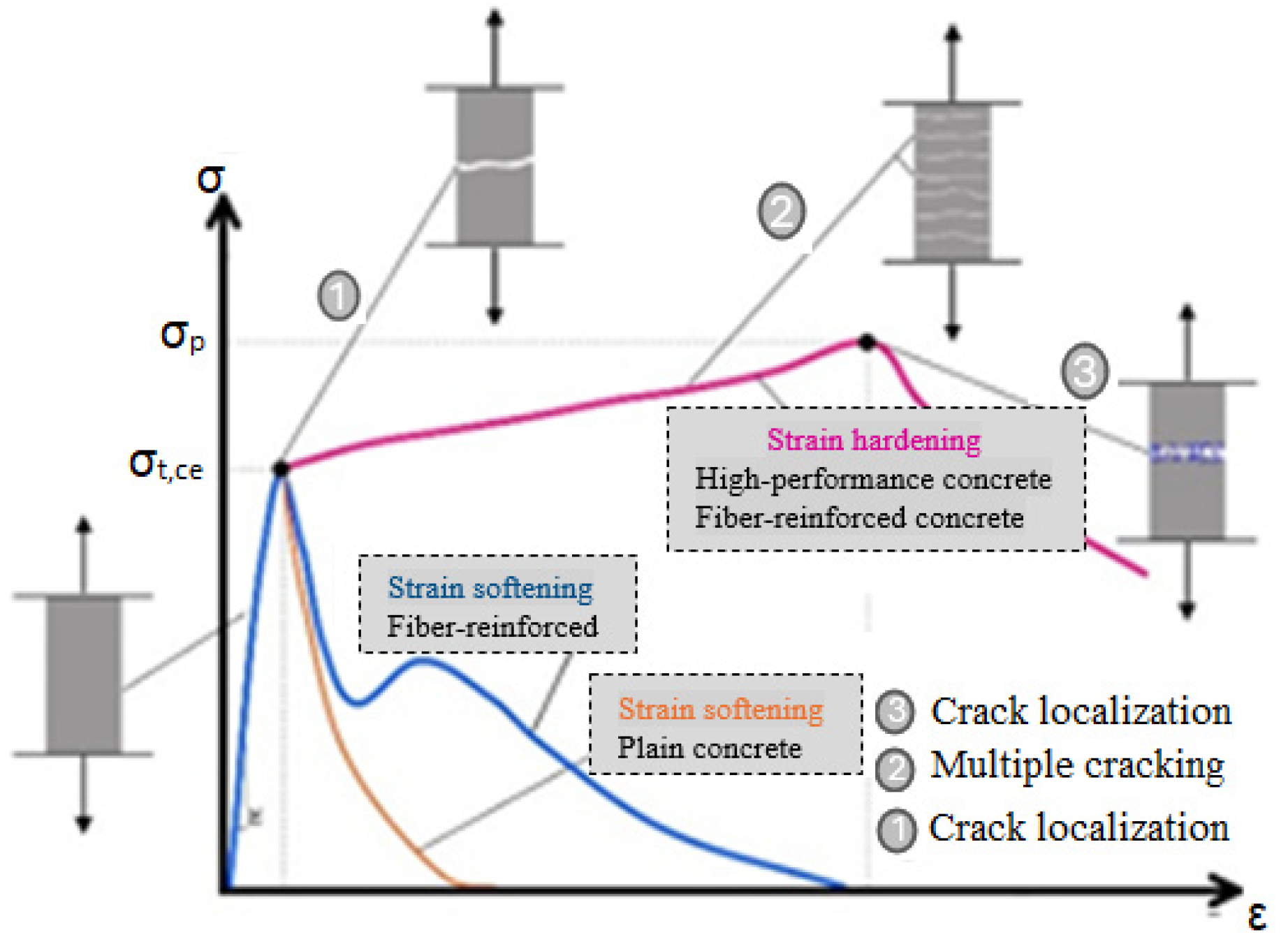

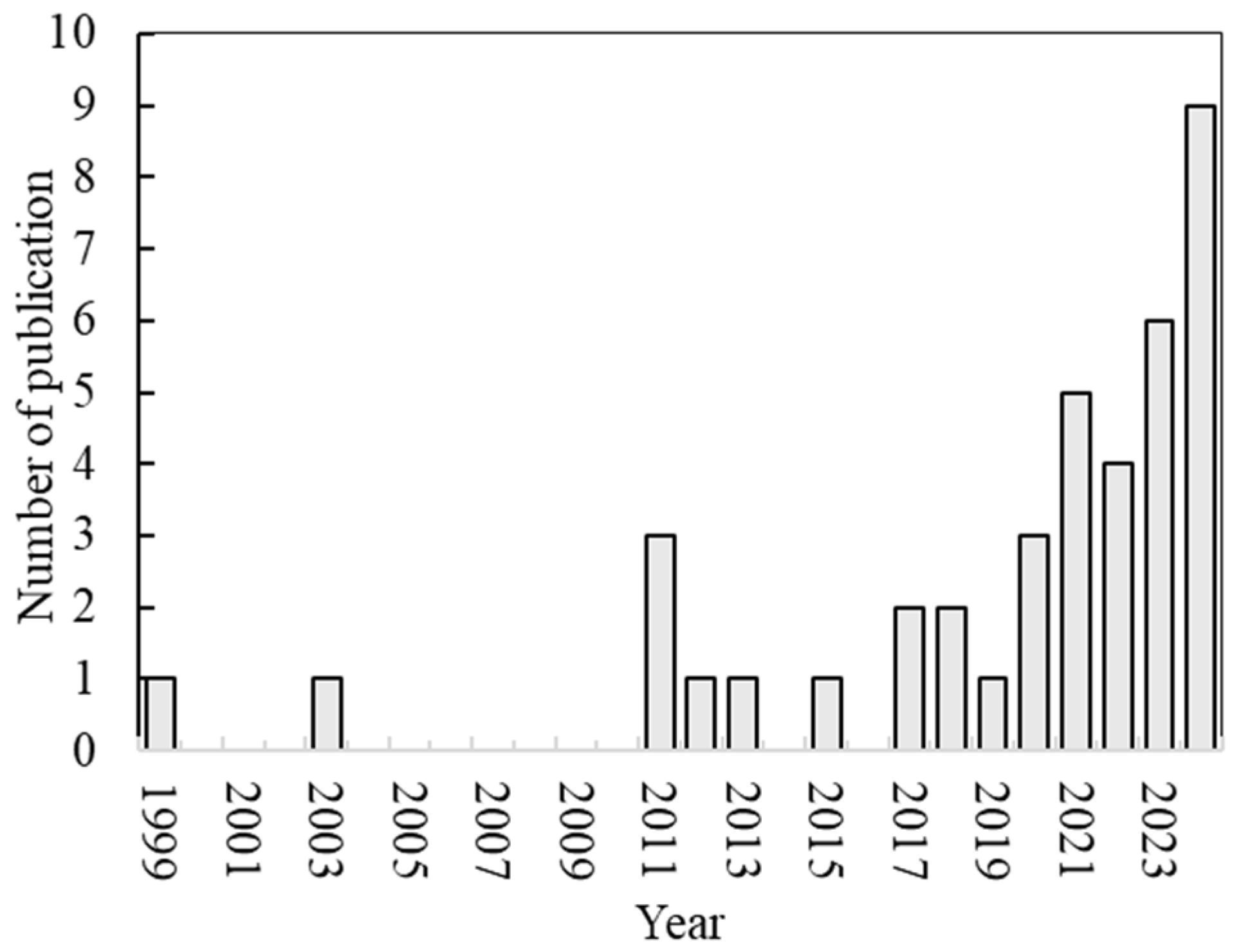
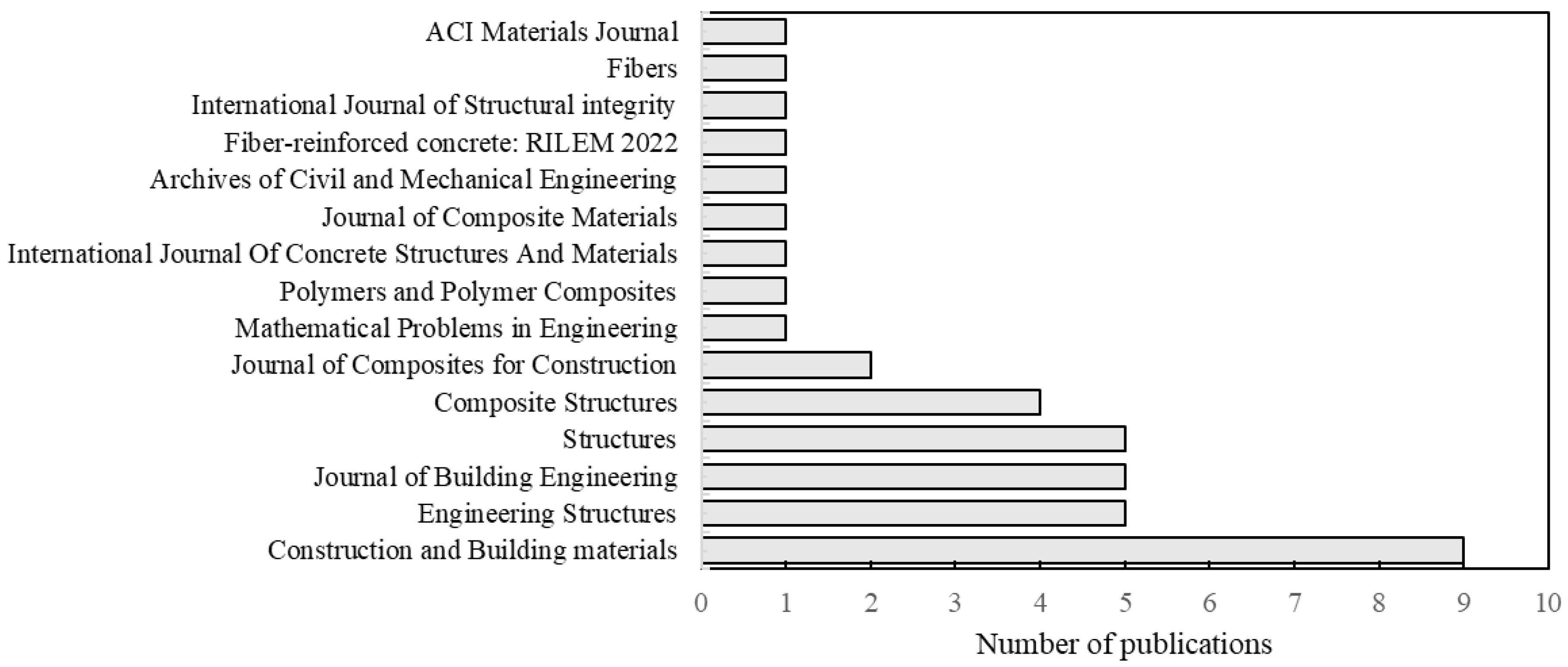
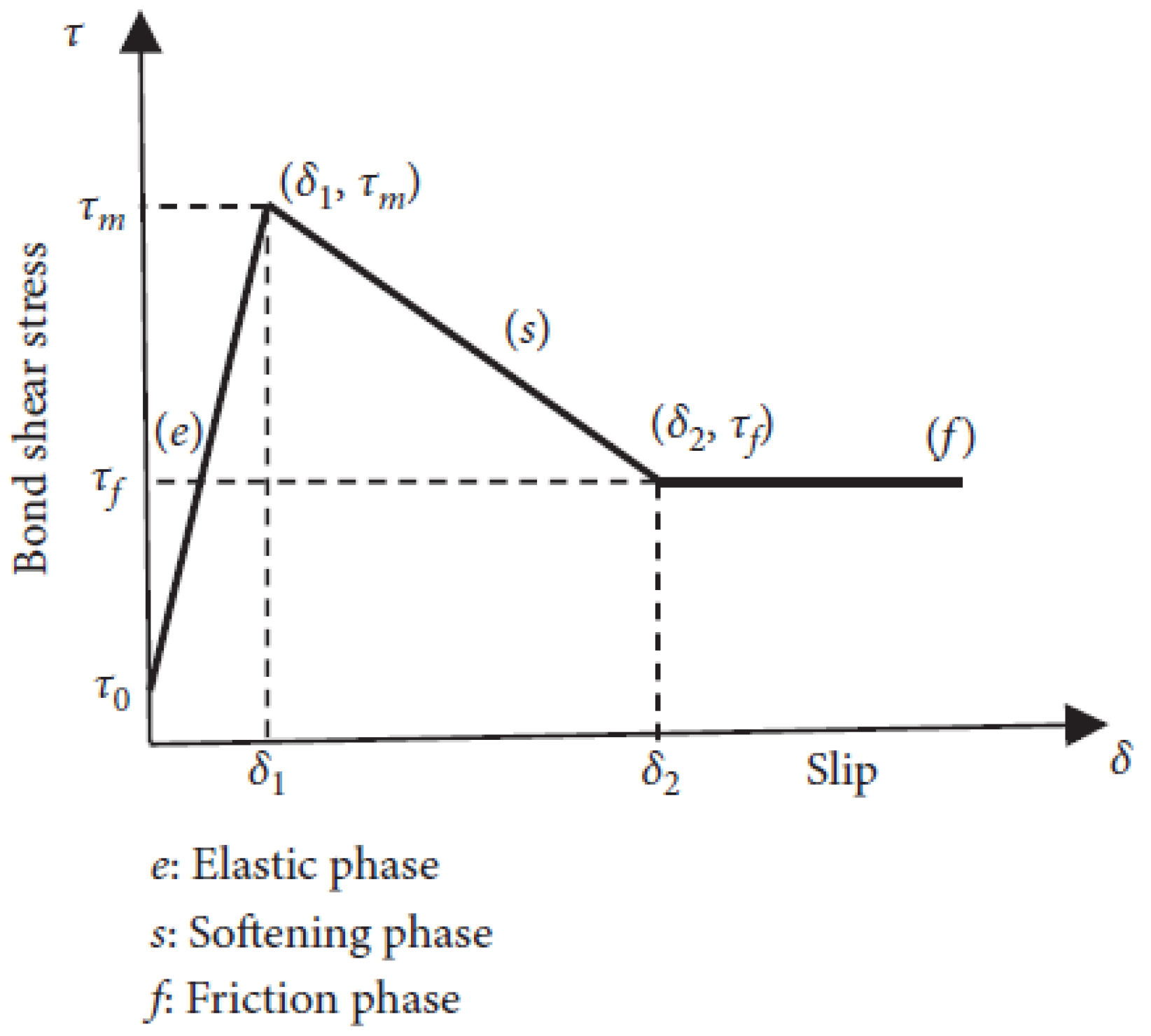

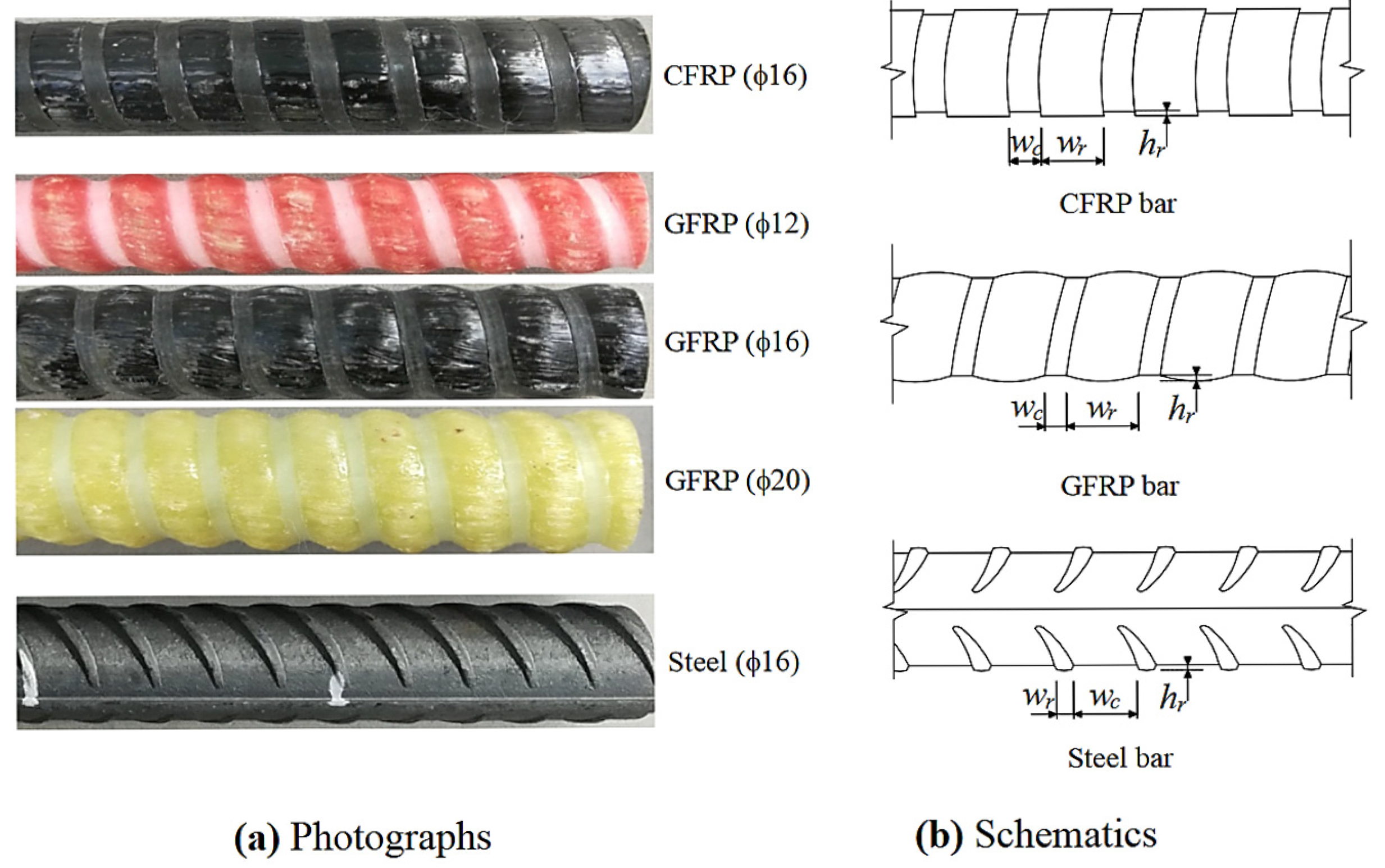
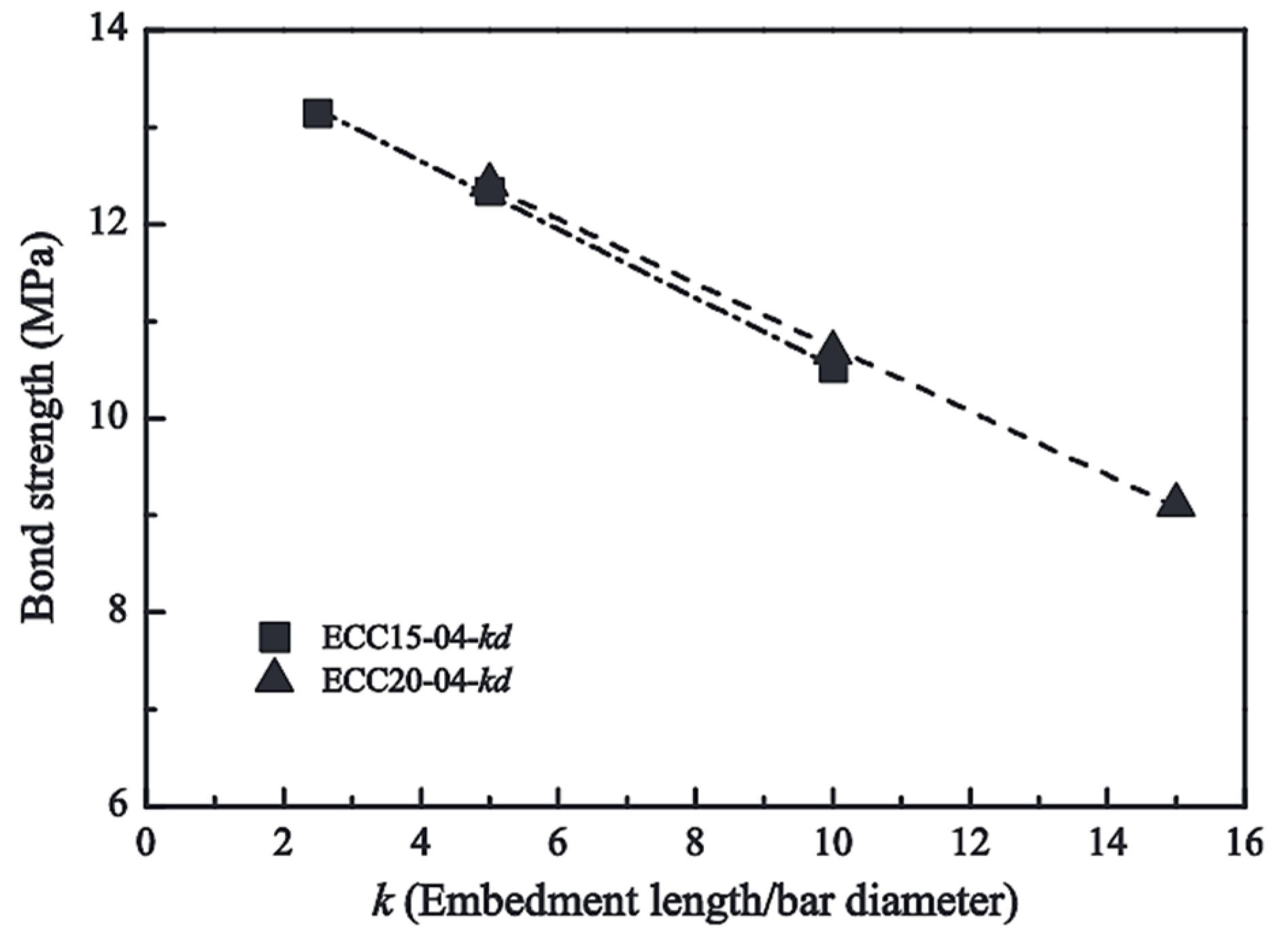
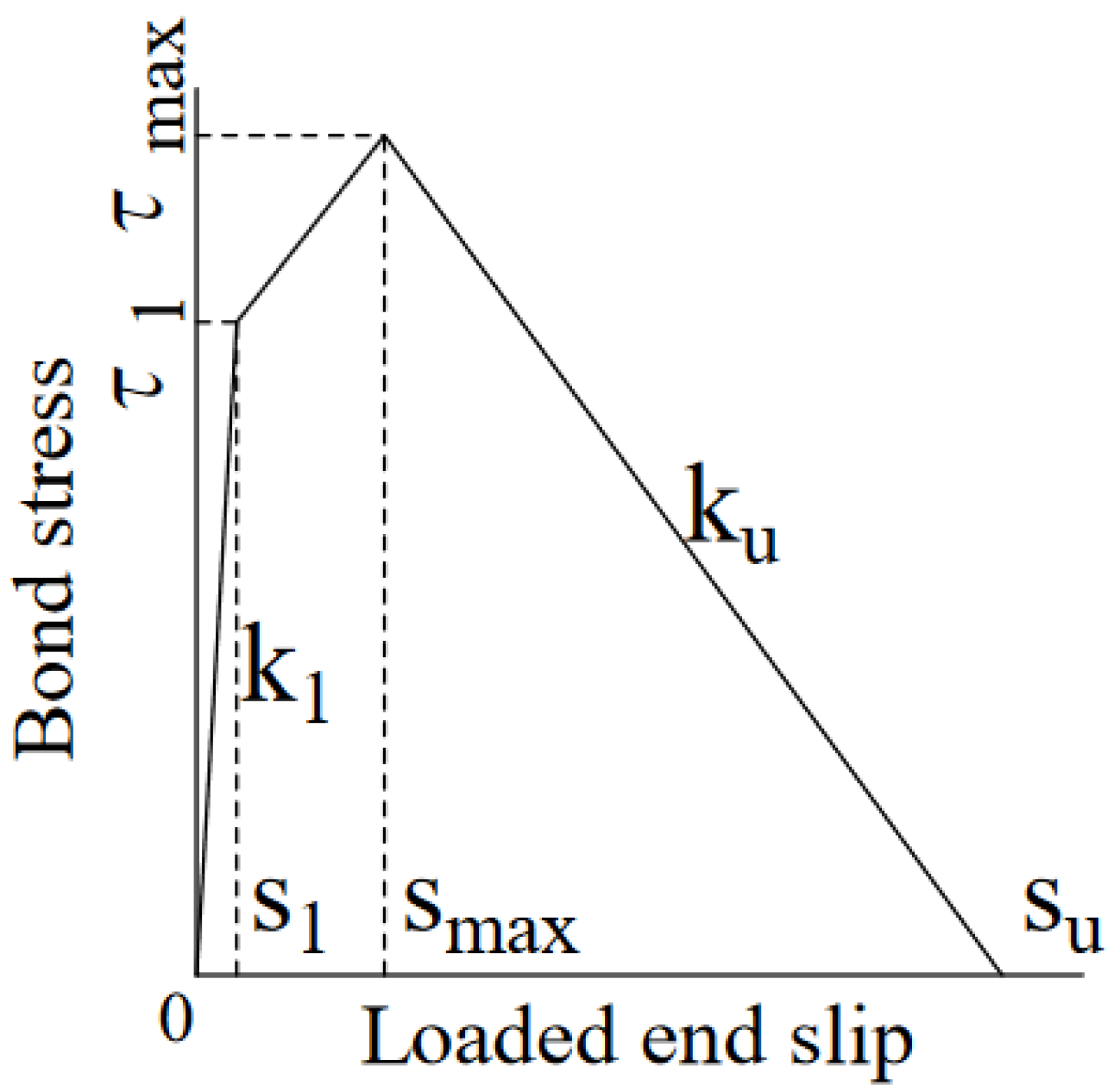
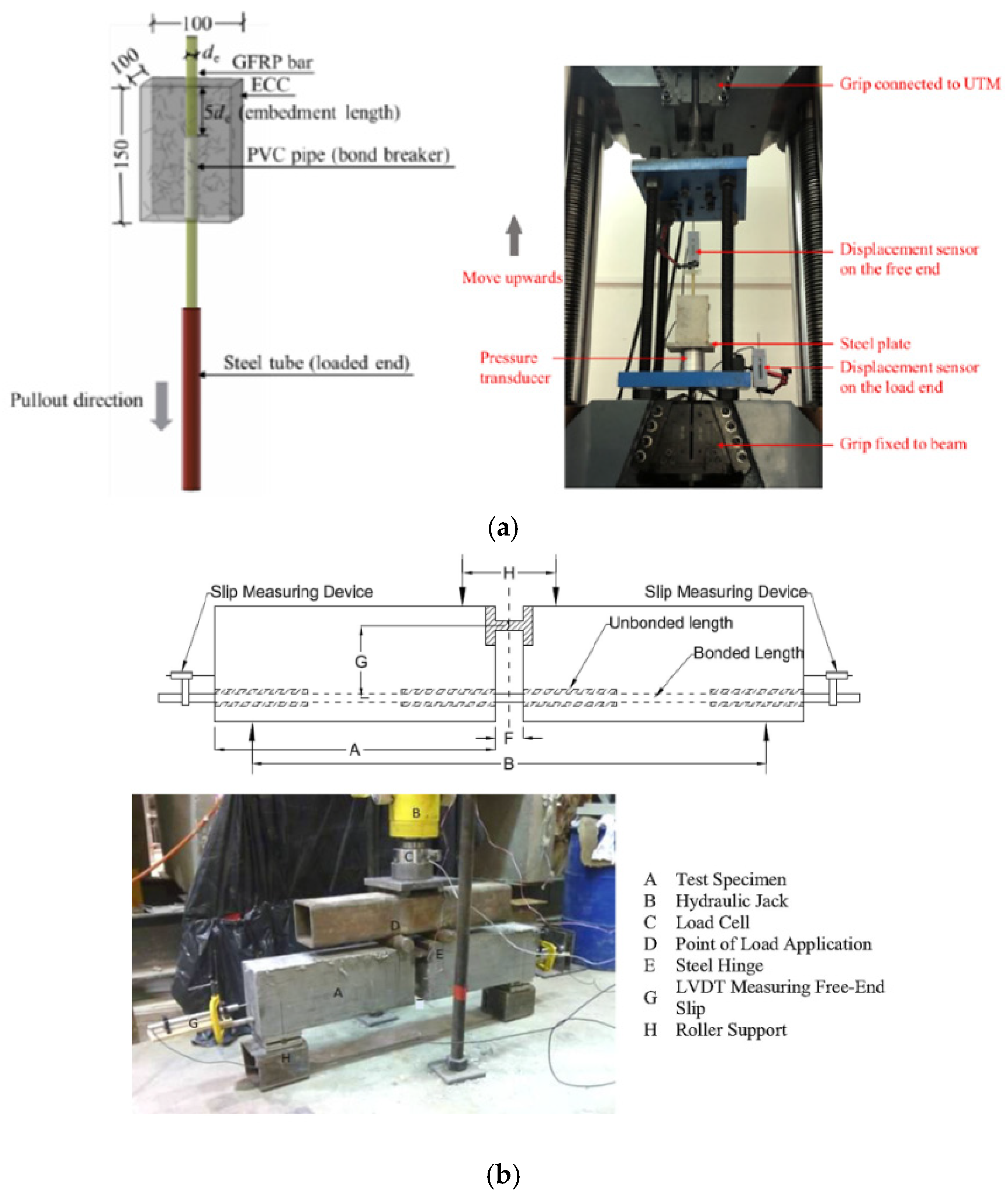
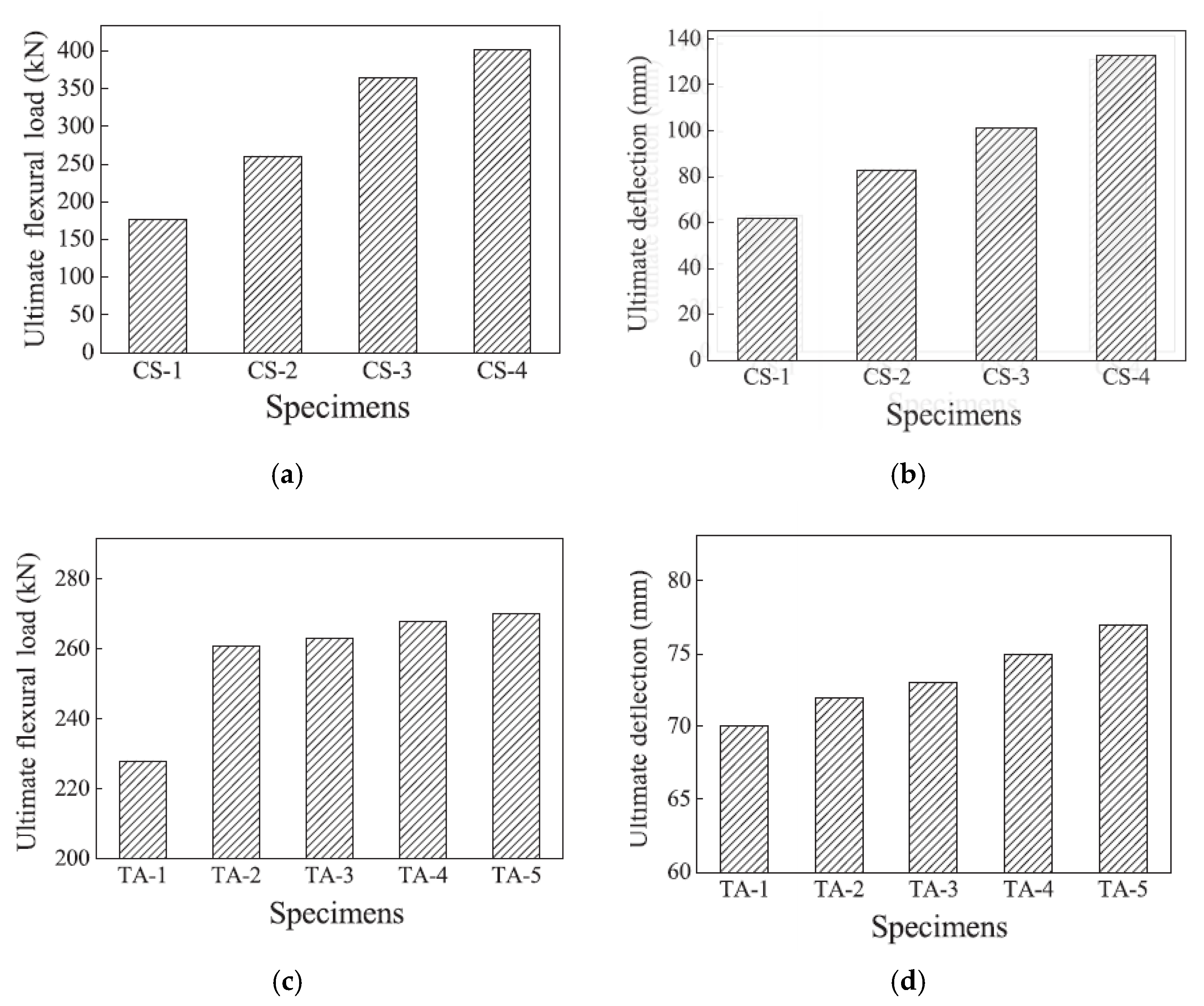
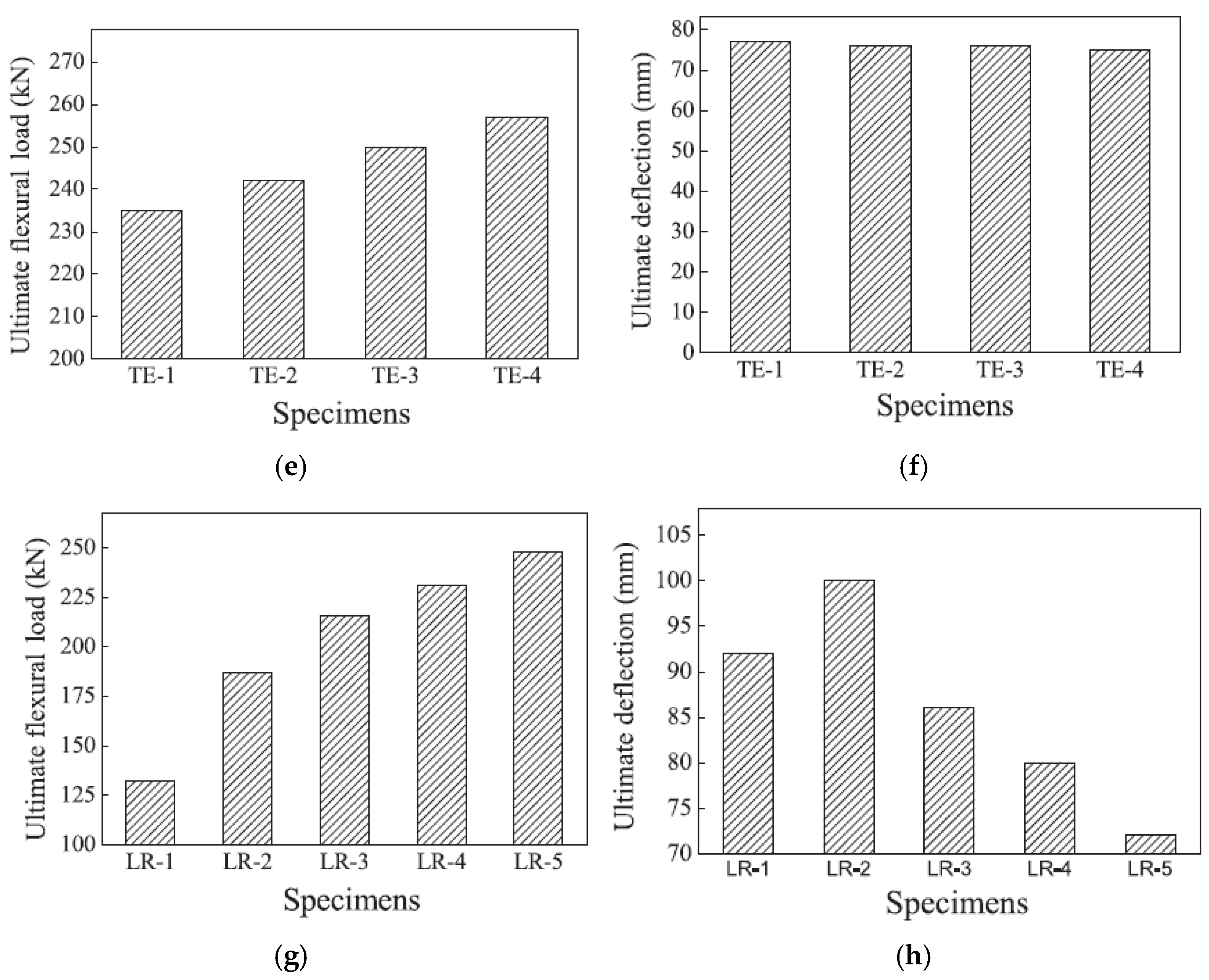


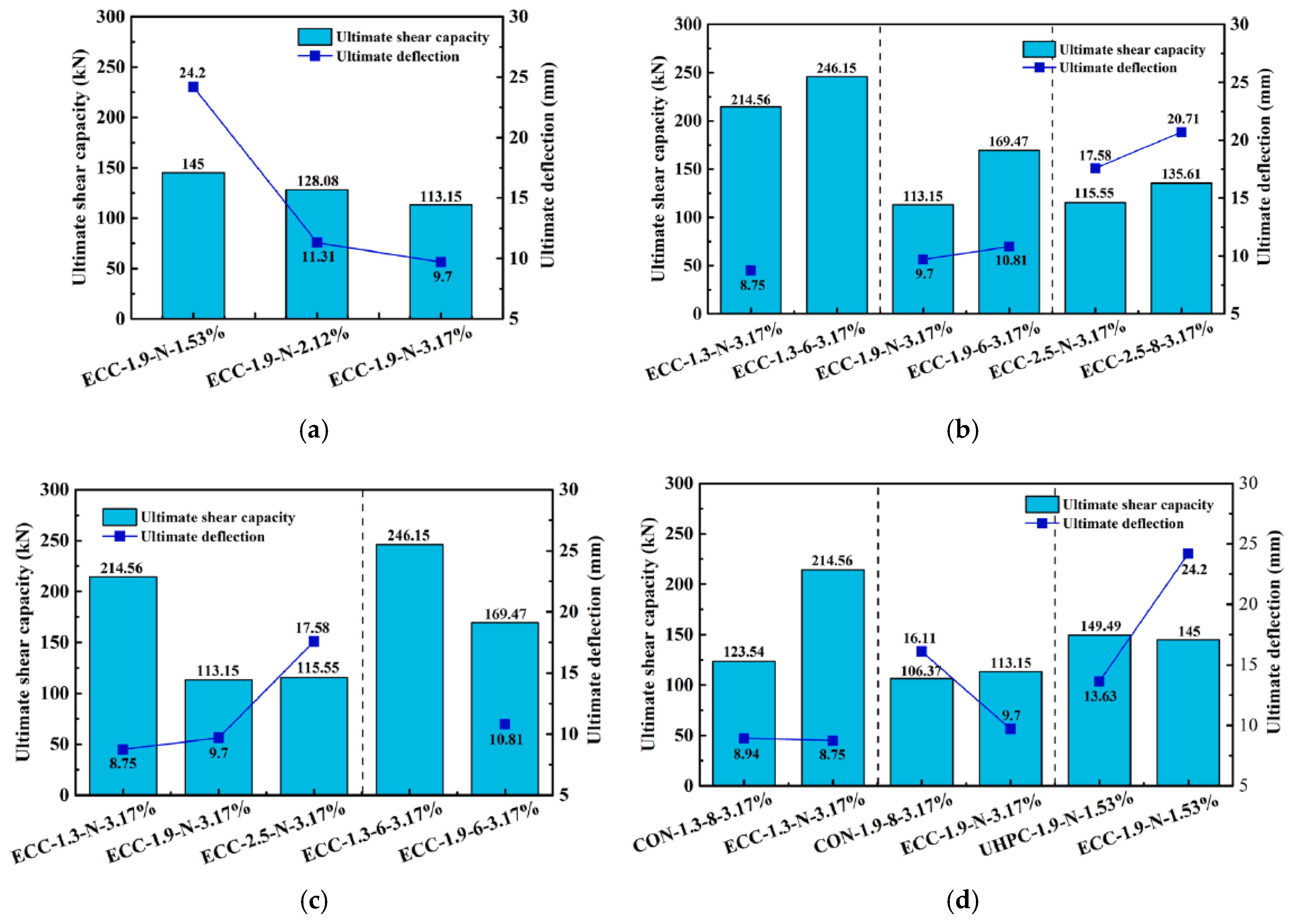
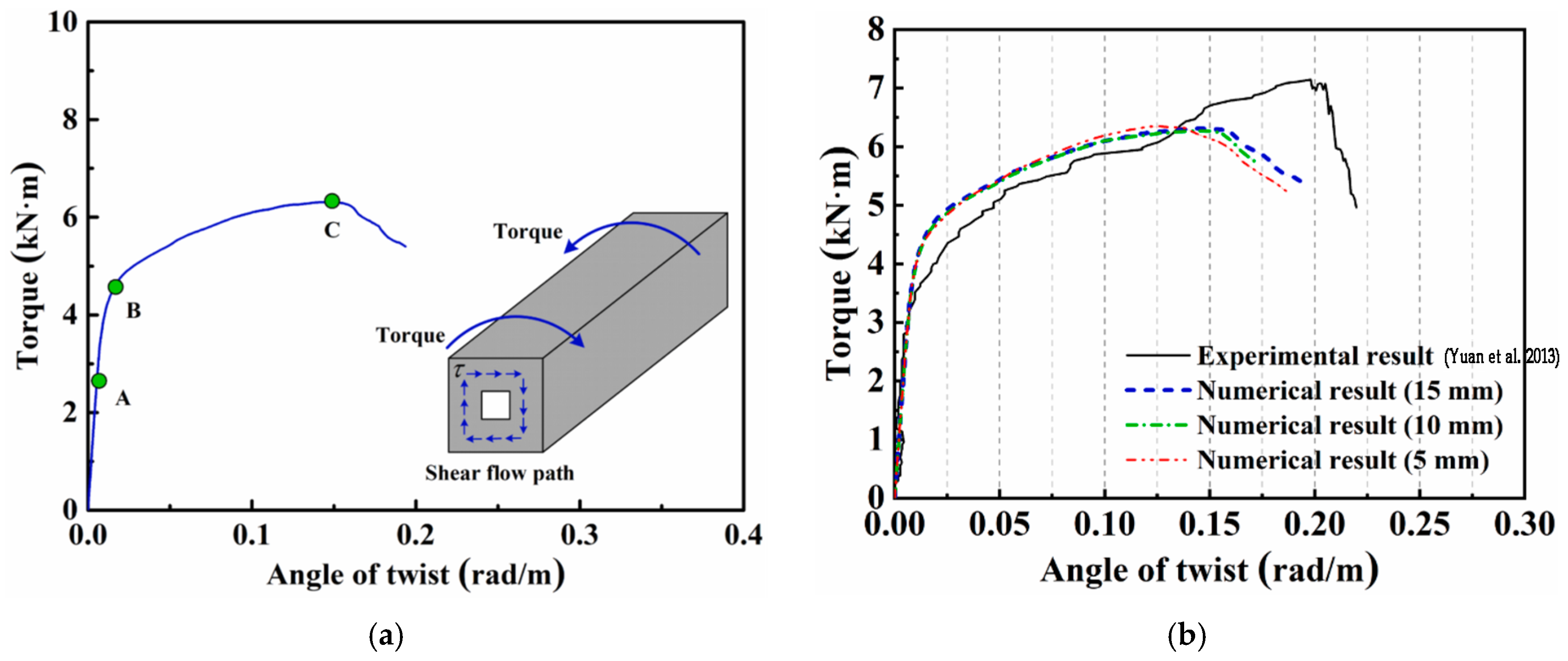
| Ref. | FRP Type | Fiber Type in FRCC | Study Type | Type of Test | Bond Strength (MPa) | Variables |
|---|---|---|---|---|---|---|
| Zhao et al. [20] | CFRP GFRP | PE | Experimental | Direct pull out | 4–15 |
|
| Li et al. [21] | GFRP | Analytical |
| |||
| CFRP | ||||||
| Takasago et al. [22] | AFRP | PVA | Experimental and analytical | Direct pull out | 6–9 |
|
| ||||||
| Hossain et al. [23] | GFRP | PVA | Experimental and analytical | RILEM beam method | 9–22 |
|
| Cao et al. [24] | BFRP | PVA | Experimental and analytical | Direct pull out | 10–20 |
|
| Wang et al. [25] | BFRP | PVA | Experimental | Direct pull out | 9–15 |
|
| Wang et al. [26] | GFRP | PVA | Experimental and analytical | Direct pull out | 2–23 |
|
| Wei et al. [27] | GFRP | PVA PE | Experimental | Direct pull out | 11–25 |
|
| Kim et al. [28] | GFRP | PVA | Experimental | Direct pull out | 17–27 |
|
| Wu et al. [29] | GFRP | PVA | Experimental and analytical | Direct pull out | 3–18 |
|
| Ref. | FRP Type | Fiber Type in FRCC | Study Type | Type of Test | Variables |
|---|---|---|---|---|---|
| Takasago et al. [22] | AFRP | PVA | Experimental and analytical | Bending test |
|
| Yuan et al. [34] | BFRP | PVA | Experimental and analytical | Bending test |
|
| Cai et al. [35] | BFRP | PVA | Analytical | Bending test |
|
| Fischer et al. [36] | AFRP | PE | Experimental and analytical | Reversed cyclic loading |
|
| Zhou et al. [37] | CFRP and GFRP | PVA | Experimental and analytical | Bending test |
|
| Wang et al. [38] | BFRP | PVA | Experimental and analytical | Bending test |
|
| Al Marahla [39,46] | GFRP | PP | Experimental | Bending test |
|
| Attia et al. [40] | BFRP | BF | Experimental and analytical | Bending test |
|
| Abushanab et al. [41] | BFRP | BF | Numerical |
| |
| Bahnam et al. [42] | GFRP | PP, GF, and SF | Analytical |
| |
| Jafarzadeh et al. [43] | GFRP | SF | Experimental and analytical | Bending test |
|
Disclaimer/Publisher’s Note: The statements, opinions and data contained in all publications are solely those of the individual author(s) and contributor(s) and not of MDPI and/or the editor(s). MDPI and/or the editor(s) disclaim responsibility for any injury to people or property resulting from any ideas, methods, instructions or products referred to in the content. |
© 2025 by the authors. Licensee MDPI, Basel, Switzerland. This article is an open access article distributed under the terms and conditions of the Creative Commons Attribution (CC BY) license (https://creativecommons.org/licenses/by/4.0/).
Share and Cite
Shiferaw, H.N.; Kanakubo, T. Structural Performance of Fiber-Reinforced Cementitious Composite Members Reinforced with Fiber-Reinforced Polymer Bars: A Systematic Review. Appl. Sci. 2025, 15, 7681. https://doi.org/10.3390/app15147681
Shiferaw HN, Kanakubo T. Structural Performance of Fiber-Reinforced Cementitious Composite Members Reinforced with Fiber-Reinforced Polymer Bars: A Systematic Review. Applied Sciences. 2025; 15(14):7681. https://doi.org/10.3390/app15147681
Chicago/Turabian StyleShiferaw, Helen Negash, and Toshiyuki Kanakubo. 2025. "Structural Performance of Fiber-Reinforced Cementitious Composite Members Reinforced with Fiber-Reinforced Polymer Bars: A Systematic Review" Applied Sciences 15, no. 14: 7681. https://doi.org/10.3390/app15147681
APA StyleShiferaw, H. N., & Kanakubo, T. (2025). Structural Performance of Fiber-Reinforced Cementitious Composite Members Reinforced with Fiber-Reinforced Polymer Bars: A Systematic Review. Applied Sciences, 15(14), 7681. https://doi.org/10.3390/app15147681







